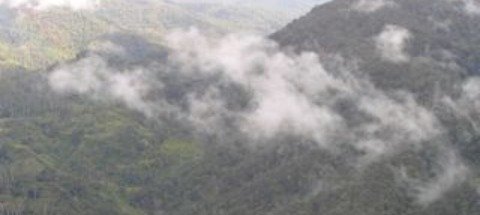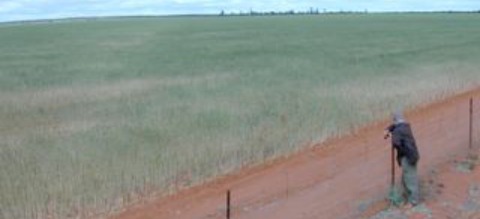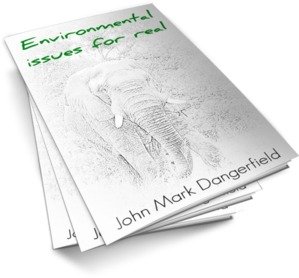Home | About CCW | Contact Us | Climate change Meaning | Causes | Solutions | Emissions | Carbon trading
Desertification
Desertification is the making of deserts.
Landscapes where plants must cope with limited moisture are deserts. The formal definitions are areas with
an average annual precipitation of less than 250 mm per year
or as areas where
more water is lost by evapotranspiration than falls as precipitation.And whilst the great deserts of the world are natural, places where rainfall is low, we now know that human activities can create deserts.
Here is how it happens.
Imagine you are on a hill, perhaps on one side of a valley. It is dawn and the light is just shaking off its orange tinge.
There is not a breath of wind as your gaze takes in the forest that blankets the hillside.
Your mind wanders in and out of the tranquility. The peace gives your eyes clarity and you begin to see what the trees are doing. A fine mist is visible above the canopy, water rising gently to the heavens.

What your eyes can see at this special time of the day is the process of evapotranspiration, the pump that allows plants to move nutrients from the soil to their leaves. For the pump to work water vapour must leave the leaves and in this early morning it is visible above the canopy, if only for a short time before the sun warms the air.
Evapotranspiration occurs all the time in all plants although the rates vary from plant to plant and slow when water is limited.
Plants are a buffer, holding on to water in their tissues as well as providing shade and cover to the soil such that under most conditions evaporation is faster than evapotranspiration - often much faster.
Desertification happens when human actions damage the evapotranspiration pump.
Cutting down trees is the most common way, especially when this happens over large areas and the trees are replaced with crops.
Several things happen when forested land is cleared for agriculture:
- moisture is no longer released in a steady stream and the air above the ground dries out
- when rain falls it hits hard and runs off so that less of the water soaks into the soil
- when rain is heavy the exposed soil is at risk of being washed away
- drier air blowing across the soil surface dries out the top layers very quickly
- organic matter (carbon) in the upper layers of soil oxidize to the atmosphere as CO2
- plant roots that were tapping water deep in the soil die cutting access to this water source
- as roots die and decay CO2 is released to the atmosphere
Here is a simpler way to understand this list.
On a summers day stand on the side of a wheat field (the local park or playing field will also do) and feel the wind.
Then walk into the forest (or a even a small stand of trees) and it will be cooler.

Combine all these effects over time and, especially in the drier parts of the world, the result matches the definition of a desert. More water leaves the system faster than it arrives and the plants struggle.
Desertification happens when vegetation is cleared or pasture overgrazed over areas large enough to lower the moisture content of air masses. Human land management has done this more often than seems reasonable.
The problem is often that the farmer who clears a field for a crop will not see the effect. It takes lots of farmers to reach the scale where desertification can happen.
In many places the consequences of climate change will include lower rainfall and higher temperatures. Where this happens in combination with large scale land clearing for agriculture the is risk of desertification is acute.
Rather than risk such an outcome, improved pasture management and cropping practices can be implemented.
Any activity that keeps vegetation cover on the landscape will be an important climate change adaptation

More reading from CCW
Environmental Issues for Real by Dr J. Mark Dangerfield looks at some of the obvious, and some of the not so obvious, challenges for a growing human population living as we do in a finite world.
Only this time it's not about the impending disasters or the guilt or the blame.
This time, it’s 10 brief essays that are about the bigger picture. In less than an hour you could glimpse something different, a view that we can only see when we take a fresh look.
Download your copy at Smashwords
Back to top of desertification | Return to Climate change effect | Back to Climate-change-wisdom home
Recent Articles
-
Reducing emissions while looking for solutions...
Nov 01, 15 04:46 PM
I've seen a lot of post's online for ideas on reducing emissions. The one suggestion I have not seen, is the most obvious. There should be a government -
Climate change evidence
Mar 24, 15 06:22 AM
Real climate change evidence has to demonstrate a change in climate. An extra sunny day or a severe storm or a flood is not enough. -
The climate change effect
Feb 19, 15 03:08 AM
What will be the climate change effect? There isn't one, there are many. Perhaps too many for us to understand.


New! Comments
Have your say about what you just read! Leave me a comment in the box below.